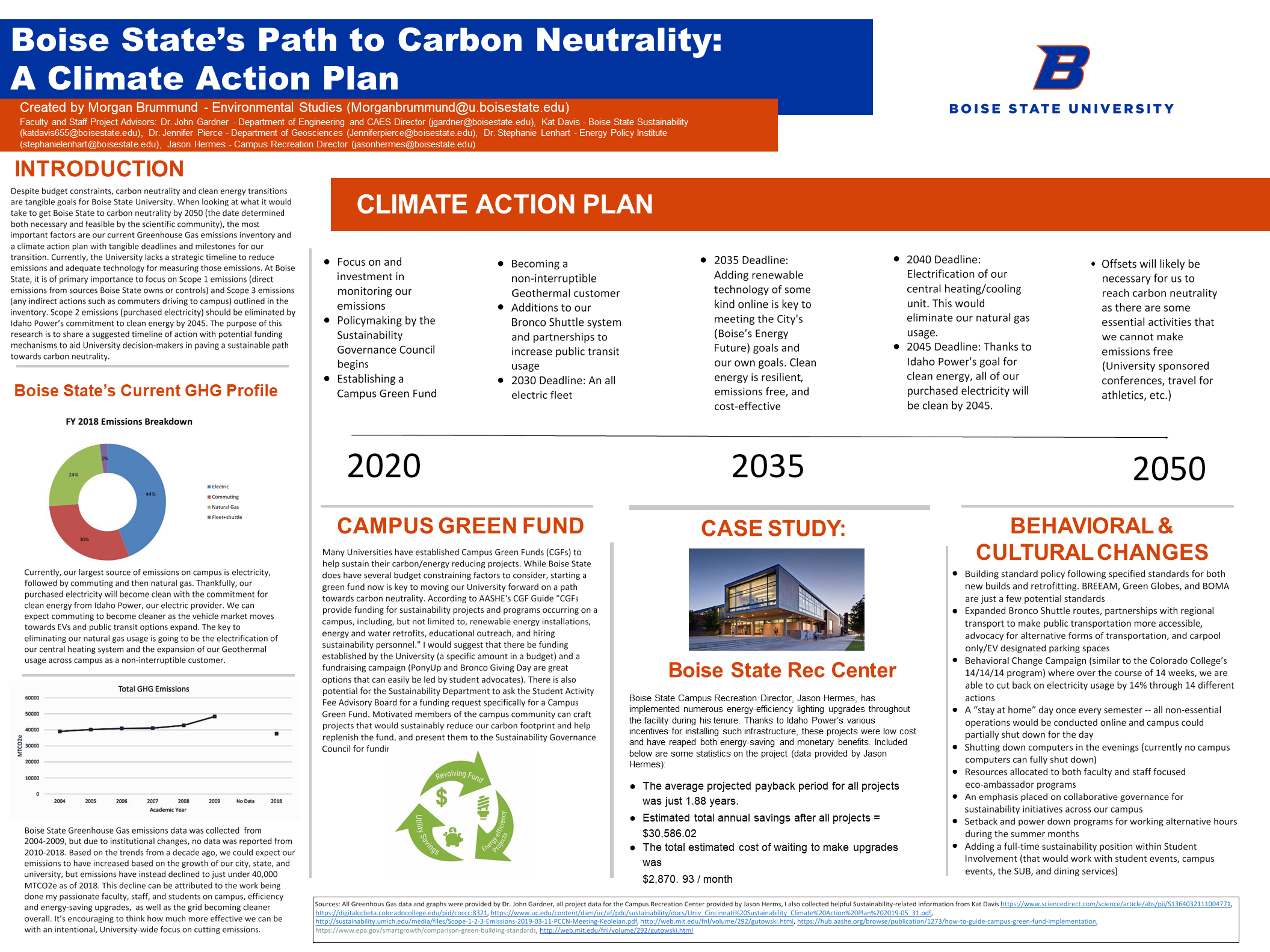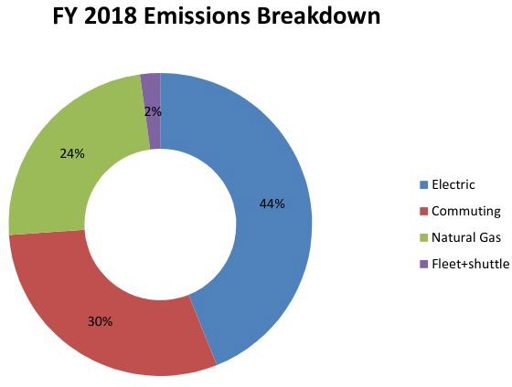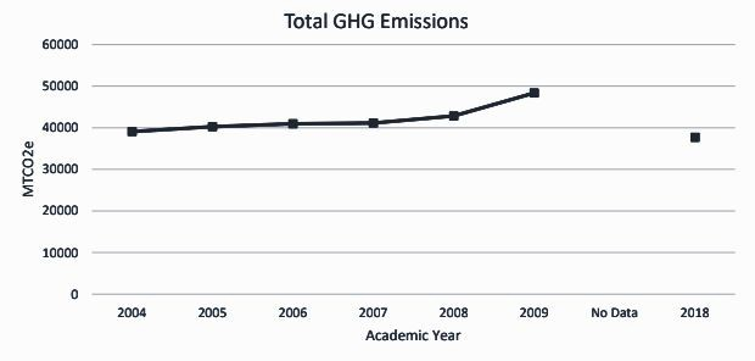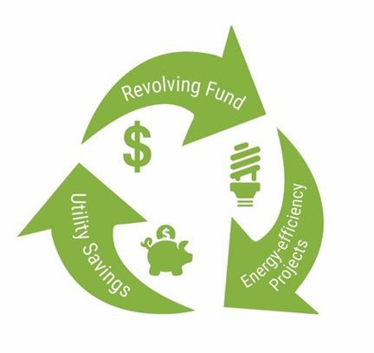Morgan Brummund, Dr. John Gardner, Kat Davis, Dr. Jennifer Pierce, Dr. Stephanie Lenhart, Jason Hermes

Introduction
Despite budget constraints, carbon neutrality and clean energy transitions are tangible goals for Boise State University. When looking at what it would take to get Boise State to carbon neutrality by 2050 (the date determined both necessary and feasible by the scientific community), the most important factors are our current Greenhouse Gas emissions inventory and a climate action plan with tangible deadlines and milestones for our transition. Currently, the University lacks a strategic timeline to reduce emissions and adequate technology for measuring those emissions. At Boise State, it is of primary importance to focus on Scope 1 emissions (direct emissions from sources Boise State owns or controls) and Scope 3 emissions (any indirect actions such as commuters driving to campus) outlined in the inventory. Scope 2 emissions (purchased electricity) should be eliminated by Idaho Power’s commitment to clean energy by 2045. The purpose of this research is to share a suggested timeline of action with potential funding mechanisms to aid University decision-makers in paving a sustainable path towards carbon neutrality.
Boise State’s Current GHG Profile

Currently, our largest source of emissions on campus is electricity, followed by commuting and then natural gas. Thankfully, our purchased electricity will become clean with the commitment for clean energy from Idaho Power, our electric provider. We can expect commuting to become cleaner as the vehicle market moves towards EVs and public transit options expand. The key to eliminating our natural gas usage is going to be the electrification of our central heating system and the expansion of our Geothermal usage across campus as a non-interruptible customer.

Boise State Greenhouse Gas emissions data was collected from 2004-2009, but due to institutional changes, no data was reported from 2010-2018. Based on the trends from a decade ago, we could expect our emissions to have increased based on the growth of our city, state, and university, but emissions have instead declined to just under 40,000 MTC02e as of 2018. This decline can be attributed to the work being done my passionate faculty, staff, and students on campus, efficiency and energy-saving upgrades, as well as the grid becoming cleaner overall. It’s encouraging to think how much more effective we can be with an intentional, University-wide focus on cutting emissions.
Climate Action Plan
Timeline
2020-2035
- Focus on and investment in monitoring our emissions
- Policymaking by the Sustainability Governance Council begins
- Establishing a Campus Green Fund
- Becoming a non-interruptible Geothermal customer
- Additions to our Bronco Shuttle system and partnerships to increase public transit usage
- 2030 Deadline: An all electric fleet
2035-2050
- 2035 Deadline: Adding renewable technology of some kind online is key to meeting the City’s (Boise’s Energy Future) goals and our own goals. Clean energy is resilient, emissions free, and cost-effective
- 2040 Deadline: Electrification of our central heating/cooling unit. This would eliminate our natural gas usage.
- 2045 Deadline: Thanks to Idaho Power’s goal for clean energy, all of our purchased electricity will be clean by 2045.
2050
- Offsets will likely be necessary for us to reach carbon neutrality as there are some essential activities that we cannot make emissions free (University sponsored conferences, travel for athletics, etc.)
Campus Green Fund

Many Universities have established Campus Green Funds (CGFs) to help sustain their carbon/energy reducing projects. While Boise State does have several budget constraining factors to consider, starting a green fund now is key to moving our University forward on a path towards carbon neutrality. According to AASHE’s CGF Guide “CGFs provide funding for sustainability projects and programs occurring on a campus, including, but not limited to, renewable energy installations, energy and water retrofits, educational outreach, and hiring sustainability personnel.” I would suggest that there be funding established by the University (a specific amount in a budget) and a fundraising campaign (PonyUp and Bronco Giving Day are great options that can easily be led by student advocates). There is also potential for the Sustainability Department to ask the Student Activity Fee Advisory Board for a funding request specifically for a Campus Green Fund. Motivated members of the campus community can craft projects that would sustainably reduce our carbon footprint and help replenish the fund, and present them to the Sustainability Governance Council for funding hearings
Case Study: Boise State Rec Center
Boise State Campus Recreation Director, Jason Hermes, has implemented numerous energy-efficiency lighting upgrades throughout the facility during his tenure. Thanks to Idaho Power’s various incentives for installing such infrastructure, these projects were low cost and have reaped both energy-saving and monetary benefits. Included below are some statistics on the project (data provided by Jason Hermes):
- The average projected payback period for all projects was just 1.88 years.
- Estimated total annual savings after all projects = $30,586.02
- The total estimated cost of waiting to make upgrades was $2,870. 93 / month
Behavioral and Cultural Changes
- Building standard policy following specified standards for both new builds and retrofitting. BREEAM, Green Globes, and BOMA are just a few potential standards
- Expanded Bronco Shuttle routes, partnerships with regional transport to make public transportation more accessible, advocacy for alternative forms of transportation, and carpool only/EV designated parking spaces
- Behavioral Change Campaign (similar to the Colorado College’s 14/14/14 program) where over the course of 14 weeks, we are able to cut back on electricity usage by 14% through 14 different actions
- A “stay at home” day once every semester — all non-essential operations would be conducted online and campus could partially shut down for the day
- Shutting down computers in the evenings (currently no campus computers can fully shut down)
Resources allocated to both faculty and staff focused eco-ambassador programs - An emphasis placed on collaborative governance for sustainability initiatives across our campus
Setback and power down programs for working alternative hours during the summer months - Adding a full-time sustainability position within Student Involvement (that would work with student events, campus events, the SUB, and dining services)
References
All Greenhouse Gas data and graphs were provided by Dr. John Gardner, all project data for the Campus Recreation Center provided by Jason Herms, I also collected helpful Sustainability-related information from Kat Davis.
- https://www.sciencedirect.com/science/article/abs/pii/S1364032111004771
- https://www.uc.edu/content/dam/uc/af/pdc/sustainabiIity/docs/Univ_Cincinnati%20SustainabiIity_Climate%20Action%20Plan%202019-05_31.pdf
- http://sustainability.umich.edu/media/files/Scope-1-2-3-Emissions-2019-03-11-PCCN-Meeting-Keoleian.pdf
- https://hub.aashe.org/browse/publication/1273/how-to-guide-campus-green-fund-impIementation
- https://www.epa.gov/smartgrowth/comparison-green-buiIding-standards
- http://web.mit.edu/fn1/voIume/292/gutowski.html
Additional Information
For questions or comments about this research, contact Morgan Brummund at morganbrummund@u.boisestate.edu.